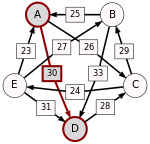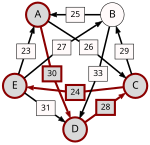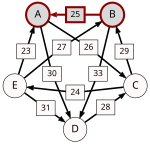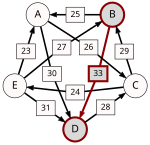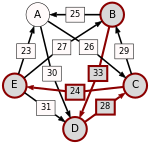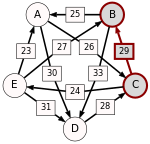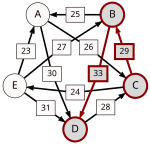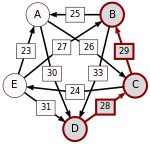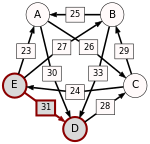Schulze method: Difference between revisions
→Use of the Schulze method: Changed: Schulze is now used for parliamentary primaries |
m →Use of the Schulze method: Linkfix |
||
| Line 452: | Line 452: | ||
[[Image:Voting2.png|thumb|right|sample ballot for [[Wikimedia Foundation|Wikimedia's Board of Trustees]] elections]] |
[[Image:Voting2.png|thumb|right|sample ballot for [[Wikimedia Foundation|Wikimedia's Board of Trustees]] elections]] |
||
The Schulze method is not currently used in parliamentary elections. However, it has been used for parliamentary primaries in the Swedish [[Pirate Party]]. It is also starting to receive support in other public organizations. Organizations which currently use the Schulze method are: |
The Schulze method is not currently used in parliamentary elections. However, it has been used for parliamentary primaries in the Swedish [[Pirate Party (Sweden)|Pirate Party]]. It is also starting to receive support in other public organizations. Organizations which currently use the Schulze method are: |
||
* [[Annodex|Annodex Association]] <ref>[http://www.cs.cornell.edu/w8/~andru/cgi-perl/civs/results.pl?id=E_50cfc592ae8f13d9 Election of the Annodex Association committee for 2007], February 2007</ref> |
* [[Annodex|Annodex Association]] <ref>[http://www.cs.cornell.edu/w8/~andru/cgi-perl/civs/results.pl?id=E_50cfc592ae8f13d9 Election of the Annodex Association committee for 2007], February 2007</ref> |
||
Revision as of 09:35, 24 January 2010
| Part of the Politics and Economics series |
| Electoral systems |
|---|
 |
|
|
The Schulze method is a voting system developed in 1997 by Markus Schulze that selects a single winner using votes that express preferences. The method can also be used to create a sorted list of winners. The Schulze method is also known as Schwartz Sequential Dropping (SSD), Cloneproof Schwartz Sequential Dropping (CSSD), Beatpath Method, Beatpath Winner, Path Voting, and Path Winner.
If there is a candidate who is preferred pairwise over the other candidates, when compared in turn with each of the others, the Schulze method guarantees that candidate will win. Because of this property, the Schulze method is (by definition) a Condorcet method.
Currently, the Schulze method is the most widespread Condorcet method (list). The Schulze method is used by several organizations including Wikimedia, Debian, Gentoo, and Software in the Public Interest.
Many different heuristics for computing the Schulze method have been proposed. The most important heuristics are the path heuristic and the Schwartz set heuristic that are described below. All heuristics find the same winner and only differ in the details of the computational procedure to determine this winner.
The path heuristic
Under the Schulze method (as well as under other preferential single-winner election methods), each ballot contains a complete list of all candidates and the individual voter ranks this list in order of preference. Under a common ballot layout (as shown in the image to the right), ascending numbers are used, whereby the voter places a '1' beside the most preferred candidate, a '2' beside the second-most preferred, and so forth.
Each voter may ...
- ... give the same preference to more than one candidate. This indicates that this voter is indifferent between these candidates.
- ... skip preferences. However, skipping preferences has no impact on the result of the elections, since only the order, in which the candidates are ranked, matters and not the absolute numbers of the preferences.
- ... keep candidates unranked. When a voter doesn't rank all candidates, then this is interpreted as if this voter:
- ... (1) strictly prefers all ranked to all unranked candidates, and
- ... (2) is indifferent among all unranked candidates.
The basic idea of the path heuristic for the Schulze method is the concept of indirect defeats, the so-called paths.
If candidate C(1) pairwise beats candidate C(2), candidate C(2) pairwise beats candidate C(3), candidate C(3) pairwise beats candidate C(4), ..., and C(n-1) pairwise beats candidate C(n), then we say that there is a path from candidate C(1) to candidate C(n). The strength of the path C(1),...,C(n) is the weakest pairwise defeat in this sequence.
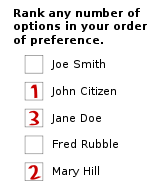
In other words:
- Suppose d[V,W] is the number of voters who strictly prefer candidate V to candidate W.
- A path is a sequence of candidates C(1),...,C(n) with d[C(i),C(i+1)] > d[C(i+1),C(i)] for all i = 1,...,(n-1).
- The strength of the path C(1),...,C(n) is the minimum of all d[C(i),C(i+1)] for i = 1,...,(n-1).
The strength of the strongest path from candidate A to candidate B is the maximum of the strengths of all paths from candidate A to candidate B.
Candidate A pairwise beats candidate B indirectly if either
- the strength of the strongest path from candidate A to candidate B is stronger than the strength of the strongest path from candidate B to candidate A or
- there is a path from candidate A to candidate B and no path from candidate B to candidate A.
Indirect defeats are transitive. That means: If candidate A pairwise beats candidate B indirectly and candidate B pairwise beats candidate C indirectly, then also candidate A pairwise beats candidate C indirectly. Therefore, no tie-breaker is needed for indirect defeats.
Procedure
Let d[V,W] be the number of voters who strictly prefer candidate V to candidate W.
A path from candidate X to candidate Y of strength p is a sequence of candidates C(1),...,C(n) with the following properties:
- C(1) = X and C(n) = Y.
- For all i = 1,...,(n-1): d[C(i),C(i+1)] > d[C(i+1),C(i)].
- For all i = 1,...,(n-1): d[C(i),C(i+1)] ≥ p.
- There exists an i, 1 ≤ i ≤ n-1 such that: d[C(i),C(i+1)] = p.
p[A,B], the strength of the strongest path from candidate A to candidate B, is the maximum value such that there is a path from candidate A to candidate B of that strength. If there is no path from candidate A to candidate B at all, then p[A,B] = 0.
Candidate D is better than candidate E if and only if p[D,E] > p[E,D].
Candidate D is a potential winner if and only if p[D,E] ≥ p[E,D] for every other candidate E.
Remark
It is possible to prove that p[X,Y] > p[Y,X] and p[Y,Z] > p[Z,Y] together imply p[X,Z] > p[Z,X].[1]: §2.3 Therefore, it is guaranteed (1) that the above definition of "better" really defines a transitive relation and (2) that there is always at least one candidate D with p[D,E] ≥ p[E,D] for every other candidate E.
Example
Example (45 voters; 5 candidates):
- 5 ACBED (that is, 5 voters have order of preference: A > C > B > E > D)
- 5 ADECB
- 8 BEDAC
- 3 CABED
- 7 CAEBD
- 2 CBADE
- 7 DCEBA
- 8 EBADC
| d[*,A] | d[*,B] | d[*,C] | d[*,D] | d[*,E] | |
|---|---|---|---|---|---|
| d[A,*] | 20 | 26 | 30 | 22 | |
| d[B,*] | 25 | 16 | 33 | 18 | |
| d[C,*] | 19 | 29 | 17 | 24 | |
| d[D,*] | 15 | 12 | 28 | 14 | |
| d[E,*] | 23 | 27 | 21 | 31 |
The graph of pairwise defeats looks as follows:

The strength of a path is the strength of its weakest link. For each pair of candidates X and Y, the following table lists the strongest path from candidate X to candidate Y. The critical defeats of the strongest paths are underlined.
| p[*,A] | p[*,B] | p[*,C] | p[*,D] | p[*,E] | |
|---|---|---|---|---|---|
| p[A,*] | 28 | 28 | 30 | 24 | |
| p[B,*] | 25 | 28 | 33 | 24 | |
| p[C,*] | 25 | 29 | 29 | 24 | |
| p[D,*] | 25 | 28 | 28 | 24 | |
| p[E,*] | 25 | 28 | 28 | 31 |
Candidate E is a potential winner, because p[E,X] ≥ p[X,E] for every other candidate X.
As 25 = p[E,A] > p[A,E] = 24, candidate E is better than candidate A.
As 28 = p[E,B] > p[B,E] = 24, candidate E is better than candidate B.
As 28 = p[E,C] > p[C,E] = 24, candidate E is better than candidate C.
As 31 = p[E,D] > p[D,E] = 24, candidate E is better than candidate D.
As 28 = p[A,B] > p[B,A] = 25, candidate A is better than candidate B.
As 28 = p[A,C] > p[C,A] = 25, candidate A is better than candidate C.
As 30 = p[A,D] > p[D,A] = 25, candidate A is better than candidate D.
As 29 = p[C,B] > p[B,C] = 28, candidate C is better than candidate B.
As 29 = p[C,D] > p[D,C] = 28, candidate C is better than candidate D.
As 33 = p[B,D] > p[D,B] = 28, candidate B is better than candidate D.
Therefore, the Schulze ranking is E > A > C > B > D.
Implementation
Suppose C is the number of candidates. Then the strengths of the strongest paths can be calculated with the Floyd–Warshall algorithm.[1]: §2.4 The following Pascal-like pseudocode illustrates the determination of such a path.
- Input: d[i,j] is the number of voters who strictly prefer candidate i to candidate j.
- Output: p[i,j] is the strength of the strongest path from candidate i to candidate j.
for i : = 1 to C
begin
for j : = 1 to C
begin
if ( i ≠ j ) then
begin
if ( d[i,j] > d[j,i] ) then
begin
p[i,j] : = d[i,j]
end
else
begin
p[i,j] : = 0
end
end
end
end
for i : = 1 to C
begin
for j : = 1 to C
begin
if ( i ≠ j ) then
begin
for k : = 1 to C
begin
if ( i ≠ k ) then
begin
if ( j ≠ k ) then
begin
p[j,k] : = max ( p[j,k], min ( p[j,i], p[i,k] ) )
end
end
end
end
end
end
The Schwartz set heuristic
Procedure
The Schwartz set heuristic for the Schulze method is an iterative heuristic.
At each stage, we proceed as follows:
- For each pair of undropped candidates X and Y: If there is a directed path of undropped links from candidate X to candidate Y, then we write "X → Y"; otherwise we write "not X → Y".
- For each pair of undropped candidates V and W: If "V → W" and "not W → V", then candidate W is dropped and all links, that start or end in candidate W, are dropped.
- The weakest undropped link is dropped. If several undropped links tie as weakest, all of them are dropped.
The procedure ends when all links have been dropped. The winners are the undropped candidates.
Example
Example (30 voters; 4 candidates):
- 3 ACDB
- 9 BACD
- 8 CDAB
- 5 DABC
- 5 DBCA
| d[*,A] | d[*,B] | d[*,C] | d[*,D] | |
|---|---|---|---|---|
| d[A,*] | 16 | 17 | 12 | |
| d[B,*] | 14 | 19 | 9 | |
| d[C,*] | 13 | 11 | 20 | |
| d[D,*] | 18 | 21 | 10 |
The graph of pairwise defeats looks as follows:

We get: "A → B", "A → C", "A → D", "B → A", "B → C", "B → D", "C → A", "C → B", "C → D", "D → A", "D → B", and "D → C".
As there is no pair of candidates V and W with "V → W" and "not W → V", no candidate can be dropped.
The weakest undropped link (A:B=16:14) is dropped.
Thus, we get:

We get: "A → B", "A → C", "A → D", "B → A", "B → C", "B → D", "C → A", "C → B", "C → D", "D → A", "D → B", and "D → C".
As there is no pair of candidates V and W with "V → W" and "not W → V", no candidate can be dropped.
The weakest undropped link (A:C=17:13) is dropped.
Thus, we get:

We get: "not A → B", "not A → C", "not A → D", "B → A", "B → C", "B → D", "C → A", "C → B", "C → D", "D → A", "D → B", and "D → C".
As "B → A" and "not A → B", candidate A is dropped and all links, that start or end in candidate A, are dropped.
Thus, we get:

The weakest undropped link (B:C=19:11) is dropped.
Thus, we get:

We get: "not B → C", "not B → D", "C → B", "C → D", "D → B", and "not D → C".
As "C → B" and "not B → C", candidate B is dropped and all links, that start or end in candidate B, are dropped; as "C → D" and "not D → C", candidate D is dropped and all links, that start or end in candidate D, are dropped.
As candidate C is the unique undropped candidate, candidate C is the unique winner.
Satisfied and failed criteria
Satisfied criteria
The Schulze method satisfies the following criteria:
- Unrestricted domain
- Non-imposition (a.k.a. citizen sovereignty)
- Non-dictatorship
- Pareto criterion[1]: §4.2
- Monotonicity criterion[1]: §4.4
- Majority criterion
- Majority loser criterion
- Condorcet criterion
- Condorcet loser criterion
- Schwartz criterion
- Smith criterion
- Independence of Smith-dominated alternatives
- Mutual majority criterion
- Independence of clones[1]: §4.5
- Reversal symmetry[1]: §4.3
- Mono-append
- Mono-add-plump
- Resolvability criterion[1]: §4.1
- Polynomial runtime[1]: §2.4"
If winning votes is used as the definition of defeat strength, it also satisfies:
If margins as defeat strength is used, it also satisfies:
Failed criteria
The Schulze method violates all criteria that are incompatible with the Condorcet criterion, such as:
- independence of irrelevant alternatives
- participation[1]: §3.7
- consistency
- invulnerability to compromising
- invulnerability to burying
- later-no-harm
Independence of irrelevant alternatives
The Schulze method fails independence of irrelevant alternatives. However, the method adheres to a less strict property that is sometimes called independence of Smith-dominated alternatives. It says that if one candidate (X) wins an election, and a new alternative (Y) is added, X will win the election if Y is not in the Smith set. Local IIA implies the Condorcet criterion.
Comparison with other preferential single-winner election methods
The following table compares the Schulze method with other preferential single-winner election methods:
| Monotonic | Condorcet | Condorcet loser | Majority | Majority loser | Mutual majority | Smith | ISDA | Clone independence | Reversal symmetry | Polynomial time | Participation, Consistency | |
| Schulze | Yes | Yes | Yes | Yes | Yes | Yes | Yes | Yes | Yes | Yes | Yes | No |
|---|---|---|---|---|---|---|---|---|---|---|---|---|
| Ranked Pairs | Yes | Yes | Yes | Yes | Yes | Yes | Yes | Yes | Yes | Yes | Yes | No |
| Kemeny-Young | Yes | Yes | Yes | Yes | Yes | Yes | Yes | Yes | No | Yes | No | No |
| MiniMax | Yes | Yes | No | Yes | No | No | No | No | No | No | Yes | No |
| Nanson | No | Yes | Yes | Yes | Yes | Yes | Yes | No | No | Yes | Yes | No |
| Baldwin | No | Yes | Yes | Yes | Yes | Yes | Yes | No | No | No | Yes | No |
| Instant-runoff voting | No | No | Yes | Yes | Yes | Yes | No | No | Yes | No | Yes | No |
| Coombs | No | No | Yes | Yes | Yes | Yes | No | No | No | No | Yes | No |
| Contingent voting | No | No | Yes | Yes | Yes | No | No | No | No | No | Yes | No |
| Sri Lankan contingent voting | No | No | No | Yes | No | No | No | No | No | No | Yes | No |
| Supplementary voting | No | No | No | Yes | No | No | No | No | No | No | Yes | No |
| Borda | Yes | No | Yes | No | Yes | No | No | No | No | Yes | Yes | Yes |
| Bucklin | Yes | No | No | Yes | Yes | Yes | No | No | No | No | Yes | No |
| Plurality | Yes | No | No | Yes | No | No | No | No | No | No | Yes | Yes |
| Anti-plurality | Yes | No | No | No | Yes | No | No | No | No | No | Yes | Yes |
This is the main difference between the Schulze method and the Ranked Pairs method:
- Suppose the MinMax score of a set X of candidates is the strength of the strongest pairwise win of a candidate A ∉ X against a candidate B ∈ X. Then the Schulze method, but not the Ranked Pairs method, guarantees that the winner is always a candidate of the set with minimum MinMax score.[1]: §9 So, in some sense, the Schulze method minimizes the strongest pairwise win that has to be overturned when determining the winner.
History of the Schulze method
The Schulze method was developed by Markus Schulze in 1997. The first times that the Schulze method was discussed in a public mailing list were in 1998 [2] and in 2000 [3]. In the following years, the Schulze method has been adopted e.g. by Software in the Public Interest (2003) [4], Debian (2003) [5], Gentoo (2005), TopCoder (2005), Sender Policy Framework (2005), and the French Wikipedia (2005). The first books on the Schulze method were written by Tideman (2006) and by Stahl and Johnson (2007). In the then following years, the Schulze method has been adopted e.g. by Wikimedia (2008) and KDE (2008).
Use of the Schulze method

The Schulze method is not currently used in parliamentary elections. However, it has been used for parliamentary primaries in the Swedish Pirate Party. It is also starting to receive support in other public organizations. Organizations which currently use the Schulze method are:
- Annodex Association [6]
- Blitzed [7]
- BoardGameGeek [8]
- Cassandra [9]
- Codex Alpe Adria [10]
- College of Marine Science [11]
- Computer Science Departmental Society for York University (HackSoc) [12]
- County Highpointers [13]
- Debian [5][14]
- Digital Freedom in Education and Youth [15]
- EnMasse Forums
- EuroBillTracker [16]
- European Democratic Education Conference [17]
- Fair Trade Northwest [18]
- Free Hardware Foundation of Italy [19]
- Free Software Foundation Europe (FSFE) [20]
- Free Software Foundation Latin America (FSFLA) [21]
- Gentoo Foundation [22]
- GNU Privacy Guard (GnuPG) [23]
- Gothenburg Hacker Space (GHS) [24]
- Graduate Student Organization at the State University of New York: Computer Science (GSOCS) [25]
- Haskell [26]
- Kanawha Valley Scrabble Club [27]
- KDE e.V. [28]
- Kingman Hall [29]
- Knight Foundation [30]
- Kumoricon [31]
- League of Professional System Administrators (LOPSA) [32]
- Libre-Entreprise [33]
- Lumiera/Cinelerra [34]
- Mason Apollonic Society [35]
- Mathematical Knowledge Management Interest Group (MKM-IG) [36]
- Metalab [37]
- Music Television (MTV) [38]
- netznetz [39]
- Noisebridge [40]
- North Shore Cyclists (NSC) [41]
- OpenCouchSurfing [42]
- Park Alumni Society (PAS) [43]
- Pirate Party of Sweden [44]
- Pitcher Plant of the Month
- Pittsburgh Ultimate [45]
- RPMrepo [46]
- Sender Policy Framework (SPF) [47]
- Software in the Public Interest (SPI) [4]
- Students for Free Culture [48]
- Sugar Labs [49]
- TopCoder [50]
- Ubuntu [51]
- Wikimedia Foundation [52]
- Wikipedia in French,[53] Hebrew,[54] Hungarian,[55] Russian,[56] and Spanish[57]
Notes
- ^ a b c d e f g h i j k Schulze, Markus (August 21, 2009). "A New Monotonic, Clone-Independent, Reversal Symmetric, and Condorcet-Consistent Single-Winner Election Method" (PDF).
- ^ See:
- Mike Ossipoff, Party List P.S., July 1998
- Markus Schulze, Tiebreakers, Subcycle Rules, August 1998
- Markus Schulze, Maybe Schulze is decisive, August 1998
- Norman Petry, Schulze Method - Simpler Definition, September 1998
- Markus Schulze, Schulze Method, November 1998
- ^ See:
- Anthony Towns, Disambiguation of 4.1.5, November 2000
- Norman Petry, Constitutional voting, definition of cumulative preference, December 2000
- ^ a b Process for adding new board members, January 2003
- ^ a b Constitutional Amendment: Condorcet/Clone Proof SSD Voting Method, June 2003
- ^ Election of the Annodex Association committee for 2007, February 2007
- ^ Condorcet method for admin voting, January 2005
- ^ See:
- Important notice for Golden Geek voters, September 2007
- Golden Geek Awards 2008 - Nominations Open, August 2008
- 2008 Golden Geek Nominees Announced - Voting Open!, September 2008
- Golden Geek Awards 2009 - Nominations Open, August 2009
- ^ Project Logo, October 2009
- ^ Codex Alpe Adria Competitions
- ^ Fellowship Guidelines
- ^ Report on HackSoc Elections, December 2008
- ^ Adam Helman, Family Affair Voting Scheme - Schulze Method
- ^ See:
- ^ Logo Competition, May 2009
- ^ See:
- Candidate cities for EBTM05, December 2004
- Meeting location preferences, December 2004
- Date for EBTM07 Berlin, January 2007
- Vote the date of the Summer EBTM08 in Ljubljana, January 2008
- New Logo for EBT, August 2009
- ^ See this mail.
- ^ article XI section 2 of the bylaws
- ^ See:
- Eletto il nuovo Consiglio nella Free Hardware Foundation, June 2008
- Poll Results, June 2008
- ^ See:
- article 6 section 3 of the constitution
- Fellowship vote for General Assembly seats, March 2009
- And the winner of the election for FSFE's Fellowship GA seat is ..., June 2009
- ^ FSFLA Voting Instructions Template:Sp icon; FSFLA Voting Instructions Template:Pt icon
- ^ See:
- Gentoo Foundation Charter
- Aron Griffis, 2005 Gentoo Trustees Election Results, May 2005
- Lars Weiler, Gentoo Weekly Newsletter 23 May 2005
- Daniel Drake, Gentoo metastructure reform poll is open, June 2005
- Grant Goodyear, Results now more official, September 2006
- 2007 Gentoo Council Election Results
- ^ GnuPG Logo Vote, November 2006
- ^ §14 of the bylaws
- ^ User Voting Instructions
- ^ Haskell Logo Competition, March 2009
- ^ A club by any other name ..., April 2009
- ^ section 3.4.1 of the Rules of Procedures for Online Voting
- ^ See:
- Ka-Ping Yee, Condorcet elections, March 2005
- Ka-Ping Yee, Kingman adopts Condorcet voting, April 2005
- ^ Knight Foundation awards $5000 to best created-on-the-spot projects, June 2009
- ^ See:
- Mascot 2007 contest, July 2006
- Mascot 2008 and cover 2007 contests, May 2007
- Mascot 2009 and program cover 2008 contests, April 2008
- Mascot 2010 and program cover 2009 contests, May 2009
- ^ article 8.3 of the bylaws
- ^ See:
- ^ Lumiera Logo Contest, January 2009
- ^ article 5 of the constitution
- ^ The MKM-IG uses Condorcet with dual dropping. That means: The Schulze ranking and the ranked pairs ranking are calculated and the winner is the top-ranked candidate of that of these two rankings that has the better Kemeny score. See:
- MKM-IG Charter
- Michael Kohlhase, MKM-IG Trustees Election Details & Ballot, November 2004
- Andrew A. Adams, MKM-IG Trustees Election 2005, December 2005
- Lionel Elie Mamane, Elections 2007: Ballot, August 2007
- ^ Wahlmodus
- ^ Benjamin Mako Hill, Voting Machinery for the Masses, July 2008
- ^ See:
- ^ 2009 Director Elections
- ^ NSC Jersey election, NSC Jersey vote, September 2007
- ^ Thomas Goorden, CS community city ambassador elections on January 19th 2008 in Antwerp and ..., November 2007
- ^ Voting Procedures
- ^ See:
- Inför primärvalen, October 2009
- Dags att kandidera till riksdagen, October 2009
- Råresultat primärvalet, January 2010
- ^ 2006 Community for Pittsburgh Ultimate Board Election, September 2006
- ^ LogoVoting, December 2007
- ^ See:
- SPF Council Election Procedures
- 2006 SPF Council Election, January 2006
- 2007 SPF Council Election, January 2007
- ^ See:
- Bylaws of the Students for Free Culture, article V, section 1.1.1
- Free Culture Student Board Elected Using Selectricity, February 2008
- ^ Election status update, September 2009
- ^ See:
- 2006 TopCoder Open Logo Design Contest, November 2005
- 2006 TopCoder Collegiate Challenge Logo Design Contest, June 2006
- 2007 TopCoder High School Tournament Logo, September 2006
- 2007 TopCoder Arena Skin Contest, November 2006
- 2007 TopCoder Open Logo Contest, January 2007
- 2007 TopCoder Open Web Design Contest, January 2007
- 2007 TopCoder Collegiate Challenge T-Shirt Design Contest, September 2007
- 2008 TopCoder Open Logo Design Contest, September 2007
- 2008 TopCoder Open Web Site Design Contest, October 2007
- 2008 TopCoder Open T-Shirt Design Contest, March 2008
- ^ Poll Results: 2009 Ubuntu Technical Board, August 2009
- ^ See:
- Jesse Plamondon-Willard, Board election to use preference voting, May 2008
- Mark Ryan, 2008 Wikimedia Board Election results, June 2008
- 2008 Board Elections, June 2008
- 2009 Board Elections, August 2009
- ^ The Schulze method is one of three methods recommended for decision-making. See here.
- ^ See e.g. here (May 2009), here (August 2009), and here (December 2009).
- ^ See here and here.
- ^ See:
- ^ See here.
External links
General
- Schulze method website by Markus Schulze
Tutorials
- Spieltheorie Template:De icon by Bernhard Nebel
- Schulze-Methode Template:De icon by the University of Stuttgart
Advocacy
- Election Methods Resource by Blake Cretney
- Voting Methods Survey by James Green-Armytage
- Descriptions of ranked-ballot voting methods by Rob LeGrand
- Accurate Democracy by Rob Loring
- Election Methods and Criteria by Kevin Venzke
- The Debian Voting System by Jochen Voss
- election-methods: a mailing list containing technical discussions about election methods
Research papers
- A Continuous Rating Method for Preferential Voting by Rosa Camps, Xavier Mora, and Laia Saumell (mirror: [1])
- Voting Systems by Paul E. Johnson
- Test Run: Group Determination in Software Testing by James D. McCaffrey
- Distance from Consensus: a Theme and Variations by Tommi Meskanen and Hannu Nurmi
- Descriptions of voting systems by Warren D. Smith
- Election Systems by Peter A. Taylor
- Personalisierung der Verhältniswahl durch Varianten der Single Transferable Vote Template:De icon by Martin Wilke
- Objective Measures of Preferential Ballot Voting Systems by Barry Wright
- Approaches to Constructing a Stratified Merged Knowledge Base by Anbu Yue, Weiru Liu, and Anthony Hunter
Books
- Saul Stahl and Paul E. Johnson (2007), Understanding Modern Mathematics, Sudbury: Jones and Bartlett Publishers, ISBN 0-7637-3401-2
- Nicolaus Tideman (2006), Collective Decisions and Voting: The Potential for Public Choice, Burlington: Ashgate, ISBN 0-7546-4717-X
Software
- Voting Software Project by Blake Cretney
- Condorcet with Dual Dropping Perl Scripts by Mathew Goldstein
- Condorcet Voting Calculator by Eric Gorr
- Selectricity and RubyVote by Benjamin Mako Hill [2] [3]
- Java implementation of the Schulze method by Thomas Hirsch
- Electowidget by Rob Lanphier
- Votator.com by Louis Philippe Lessard [4]
- Haskell Condorcet Module by Evan Martin
- Condorcet Internet Voting Service (CIVS) by Andrew Myers
- BetterPolls.com by Brian Olson
- OpenSTV by Jeffrey O'Neill



